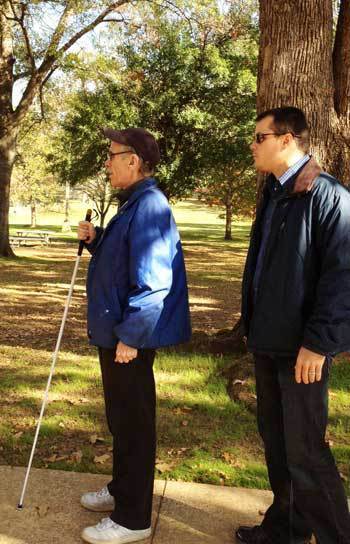The blind are far from a monolithic group. There are those who are congenitally blind, meaning they had no eye sight at birth, and then there are those who became blind later in life. These two categories of blind people may navigate the built environment a bit differently. Describing a very small study of how congenitally-blind and late-blind people navigate a shopping district and an urban park in Izmir, Turkey, Fehmi Dogan, professor of architecture at the Izmir Institute of Technology, presented some interesting observations at the Environmental Design Research Association (EDRA) conference in Los Angeles.
Congenitally-blind people may more easily access their other senses, like touch, smell, and hearing, while late-blind people may more easily use their memory to navigate. In general, the blind were most aware of sound and least aware of temperature changes. Both groups preferred navigating the busy streets, with all their obstacles, to the park. For the blind overall, the city is a truly "multi-sensory phenomenon."
Of the seven participants (4 men and 3 women), the mean age was 28. Each uses a white cane or "eye stick" to get around. "They all have a self-sustaining life and are good travelers," added Dogan. Each participant was sent through a set of trials for 6 hours, walking a 900-meter-path either through a busy commercial district or a park, each with a range of obstacles to confront.
Researchers walked the paths with them the first go-around and then they walked it again alone and were asked to describe important reference points, including whether they used their memory or a sense (touch, smell, or hearing) to navigate. These reference points, which totaled in the hundreds, were then examined in greater detail. Dogan emphasized that this study is in "no way generalizable or conclusive," but merely observational.
In the shopping district, the congenitally blind were especially attuned to all the sensory experiences on the course. Even the congenitally blind can see light and dark. "They followed the echo of the sun." They also closely read air movements, so they could sense when they had reached a crosswalk or intersection because the air flow changed.
Dogan read from some of the blind participants' own references. The sound of high heels clicking on a sidewalk helped one subject orient themselves. They used echos to identify the streets on three sides. Another listened for the time it took for a bird to leave the ground and alight on a building roof, which allowed them to calculate the roof's height.
For some, texture was significant. They followed the drain inlets in streets. "On straight walks, they needed to use the inlets to create a line to follow."
And among the congenitally blind, the sense of smell was most used. They were able to plot themselves based on the smell of coffee, corn, even new clothes. However, smell can easily change with air movement.
For the late blind, all these other senses were also used, but they could more easily use their memory to determine where they were. One remembered that when they heard street sellers, they turned to reach the end point. They could tell they were near the street sellers when they hear the sound of paper bills. "Late blind didn't comment on touch."
For both the congenitally blind and late-blind, the park was more challenging. "It all smelled like grass. It was much harder to navigate because it was so homogenous." All participants felt more safe and comfortable in the shopping district, despite all of its obstacles. "This is because they could ask questions when people were around them."
Dogan said for the blind, "spatial experiences are understood more if they are multi-dimensional."

